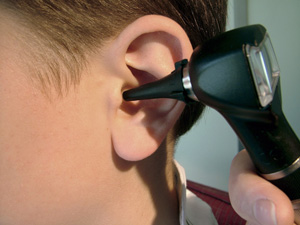Burst Eardrum

Causes And Symptoms Of A Burst Eardrum
A burst eardrum is definitely not a fun thing to experience, even though the long term effects are normally not as serious as one may be led to believe. When the eardrum, or tympanic membrane, is burst or perforated, one might think that besides the pain, there would be a total loss of hearing in that ear. That there will be pain is beyond question, but the effect on hearing is somewhat of a variable.
External Causes - The cause of a burst eardrum can be external or internal. An external cause could be a sharp object, which could create a puncture wound. We are taught at an early age not to put sharp objects, or any objects for that matter, in our ears, for good reason. If the eardrum is punctured by a sharp object, it should not be left unattended, Even if the perforation is not excessively large, there is always the possibility of infection. It is also possible that the middle ear or inner ear could have suffered damage, and not just the eardrum.
A blow to the head could also cause the tympanic membrane to burst. Seeking treatment is also advised in this case. The risk of infection may be lower, but a blow to the head, strong enough to result in a burst eardrum, could easily cause other damage requiring treatment. Another external cause can be a very loud and sudden noise. In this case, the damage done is most likely to be confined to the eardrum, and infection is not likely to become an issue. It is still advisable to see a physician, although if the opening in the eardrum is not too large, it will generally heal by itself.
Internal Causes - An eardrum may at times burst because of an internal cause. This is usually due to a bacterial or viral infection in the middle ear. Detritus, or pus, which builds up will put pressure on the eardrum, and this pressure can sometimes be strong enough to cause the eardrum to burst. This is a case where a burst eardrum is almost welcomed, in spite of the pain, as the pain caused by the pressure may have approached an intolerable level. When the pain accompanying the bursting process has subsided, the ear may feel better than it did before the eardrum burst.
Symptoms - The symptoms of a burst eardrum almost always include sudden sharp pain, at times excruciating pain. This condition is fortunately usually not long lasting, and the pain will become much milder. The throbbing pain that is initially felt is due to the middle and inner ear coming into direct contact with air. There may also be a feeling of dizziness or vertigo, and perhaps even nausea. These symptoms also usually subside over a period of a few days as the eardrum begins to heal. If the damage is due to an internal infection, there will most likely be a discharge of pus from the ear, accompanied by bleeding.
Some experience a ringing in the ear. This condition also will pass eventually. Insofar as hearing loss is concerned, that is expected, but it is not necessarily a total loss of hearing that will be experienced. We hear sounds, because the vibration in the air causes a vibration in the tympanic membrane. If there is only a small puncture or perforation, the membrane will continue to vibrate, though not as effectively as before. Hearing in that case will not be lost, though it will likely be impaired. How much is often determined by the size of the tear or perforation as well as its location.
Treatment - The usual treatment will consist of prescribed antibiotics to prevent infection, together with pain medication as may be needed. Bed rest is usually recommended if dizziness or vertigo is experienced, and care must be taken to keep water out of the ear when bathing or showering. In many cases, the eardrum will heal itself within 2 or 3 weeks. In more extreme cases, where the perforation is too large to allow the burst eardrum to effectively heal on its own, surgery may be required. This can usually be accomplished on an outpatient basis, using a local anesthetic. The most frequently used procedure is called myringoplasty, which is essentially plastic surgery on a small scale. Living tissue is removed from another part of the body, usually near or behind the ear, and is used as a "patch" on the eardrum.
Whether a burst eardrum heals on its own, or surgery is needed, there will always be some scar tissue formed, a natural part of the healing process. The presence of scar tissue can effect how the tympanic membrane vibrates, but in most cases the affect on hearing is barely noticeable, if noticeable at all.